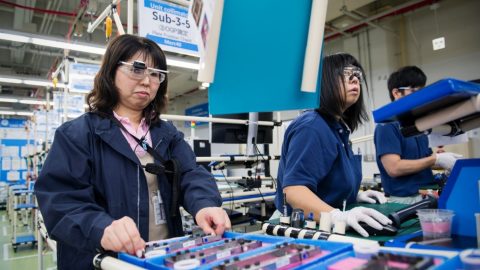
Workers at Hino factory rely on smart glass to improve productivity
If you want to see the future of manufacturing, follow the Tama River about 45 kilometers upstream from Tokyo’s Haneda Airport to the GE Healthcare facility in Hino, Japan. Inside this outwardly conventional, low-rise suburban business complex is emerging the blueprint for the future of manufacturing, tweak by painstaking tweak.
The Hino factory makes both parts for large medical scanners and small, precision equipment. Compared with similar facilities, its production lines are exceptionally efficient — fast, with less waste, errors and unplanned downtime — thanks in part to the successful integration of advanced digital information technology with operational systems. GE calls this convergence of hardware and software on the shop floor the brilliant factory.
But the brilliance lies less in sensors and radio-frequency identification (RFID) tags than in the approach that guides their use: a deft blending of Lean principles designed to eliminate waste in manufacturing and advanced digitization that enables the constant fine-tuning of production.
In that respect, the Hino plant is where the Industrial Internet meets Kaizen, the Japanese concept of continuous improvement pioneered by Toyota after World War II that undergirds Lean methods for eliminating waste in manufacturing. “What we’re doing is applying digital tools, advanced manufacturing solutions, on top of a Lean foundation,” explains Frederick Mauermann, general manager for global lean manufacturing at GE Healthcare. “That’s the recipe we’ve found that provides the greatest payback.”
The approach is working. Atsushi Morimoto, who runs operations at the Hino plant, says that digitization and Lean manufacturing create powerful synergies that “maximize the effectiveness of the company’s investment.” Lead times for some of Hino’s products have shrunk by up to 65 percent. One line produces CT scanner gantries, the big donut-shaped enclosures that surround a patient and contain the scanner’s X-ray tubes and other detectors. When GE Healthcare Japan began operation in 1982, lead time for manufacturing a gantry was nearly a week. Today, that production window is measured in minutes. “
GE has seven of these factories — each of them a laboratory, training location and profitable manufacturing site rolled into one. GE launched the brilliant factory initiative in 2015 and expects to have 18 by the end of the year.
Because operational bottlenecks and other stumbling blocks differ by industry and product, the goals and expected results of digitalization also vary. But the guiding principle is the same across them all: Constantly seek incremental improvements that increase efficiency and quality.
What sets Hino apart is a deep and sustained commitment to Kaizen. By participating in Kaizen workout activities, employees of all levels are empowered to contribute their own insights and test potential operational changes. The factory adheres to the concept of standard work, wherein tasks are clearly defined and repeated many times in order to highlight opportunities to remove inefficiencies.
“If you step into that factory, your biggest takeaway will be the attention to detail and how well defined the standard work is,” Mauermann says. “The team there works constantly to optimize production, which can mean eliminating any need to walk away from the line to find a tool or get a part. They’ve developed ways to bring what they need to them, when they need it.”
Source: GE Report